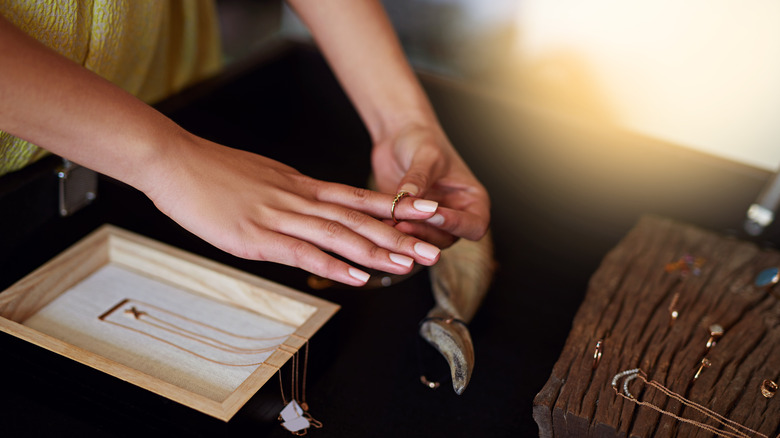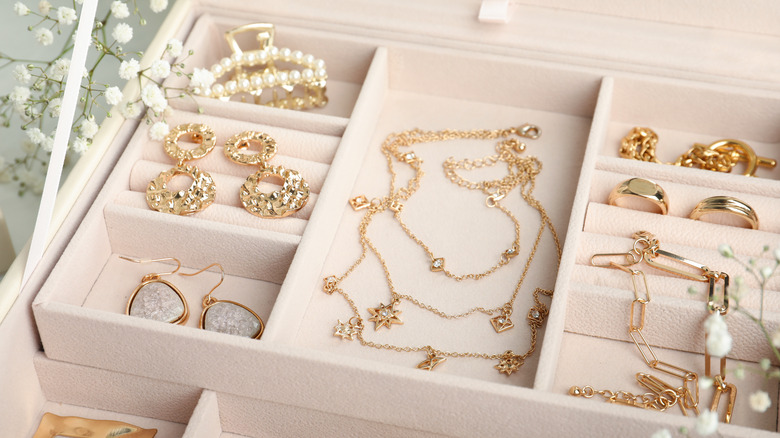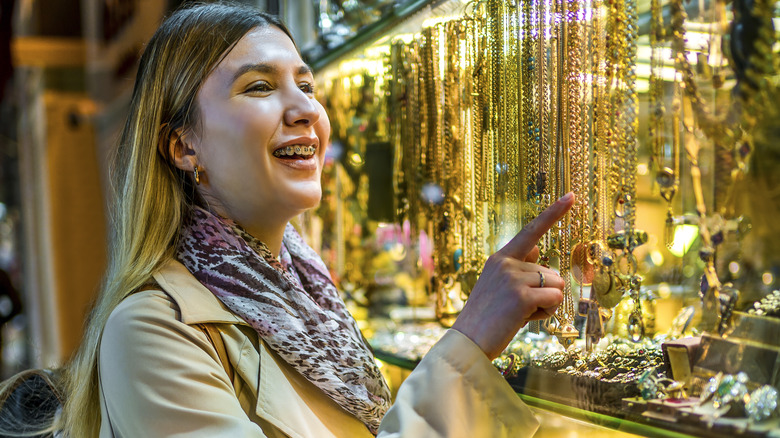Cost-Effective Gold Alternatives That Deserve A Space In Your Jewelry Collection
If you've been lucky enough to be gifted a real gold ring, bracelet, or earrings, it probably marked a momentous occasion — a major birthday, graduation, or marriage. Solid gold has been cherished, passed down, and traded across the centuries because of its burnished glow, and resistance to corrosion, rust, or tarnishing. Yet, the price of gold fluctuates and might be over $2000 per ounce on any given day, making solid gold swag completely out of reach for many.
Luckily, three cost-effective gold alternatives — gold plated, gold vermeil, and gold filled — abound. The benefits vary, but all three have much lower price points than the real thing. Plus, they're effortless to find online, and one of them looks almost exactly like solid gold.
Although even pure gold is mixed with an alloy, it won't tarnish. Keep in mind that all gold alternatives will tarnish to a greater or lesser extent. As you explore what materials, designs, and alternatives you prefer, you can also weigh the costs against your budget. But let's consider the gold alternatives that deserve space in your collection.
All about gold-plated jewelry
Using price as a starting point, gold-plated jewelry is the least expensive and most readily available of the three. There are a multitude of designs from delicate pieces to bold statement jewelry. To make this alternative, jewelers electroplate (which means to deposit using a chemical and an electrically charged process) an exceptionally thin layer of gold over brass, copper, or some other combination base metal.
There are zero minimum thickness or karat weight rules for gold plating, so an extra thin gold layer can and usually does rub off. Copper or other metals rubbing against the skin can deposit a telltale greenish color. Gold-plated pieces are your most affordable option, and they're everywhere. If you need something that looks like a luxury item you can pair with your everyday outfits but that's super budget-friendly, this is your go-to. A few cons to keep in mind: plating is the most likely to rub off, so it won't last as long as others. Also, it can irritate sensitive skin and will tarnish.
All about gold vermeil
Gold vermeil is created in a similar way as gold-plated pieces, but is pricier and more valuable. The gold is electroplated onto high-quality silver, not a base metal. It also has to meet certain standards. The gold's purity must meet a 10k standard or higher and be 2.5 microns thick or more.
You can tell the difference between plated and vermeil pieces by sight; vermeil is marked "925", which means it's real sterling silver. Gold vermeil is less expensive than pure gold but still valuable because it's made with real silver. It's hypoallergenic and can be a better choice for sensitive skin. The higher the karat used, the more it looks like real gold.
The cons here are that the gold layer can also wear off over time and it's less durable than gold. Also, the available designs are more limited. Depending on the jeweler's design choices, sometimes vermeil can actually be pricier than gold-filled.
All about gold filled
Gold-filled jewelry is often the most expensive (of the alternatives), though still significantly lower than solid gold. It's crafted differently; instead of electroplating, to create gold fill, jewelers take a few layers of gold and use heat and pressure to bond it to a wire, which could be jeweler's brass or another metal. The filling is metal, and the exterior is gold. To qualify as gold-filled, the weight of the piece needs to contain at least 5% real gold.
Though more expensive than the other options, if you can spring for gold-filled, go for it. It resembles solid gold the most and has excellent strength and durability. It's also hypoallergenic. It's the most enduring of the three alternatives.
The cons of gold-filled jewelry are that, like vermeil, there are fewer styles and designs available. It will tarnish the least but can still wear over time. For maximum longevity, you should clean all of your jewelry with a soft cloth, separating the pieces so they don't scratch each other, and keeping them in a cool, dark place to prevent erosion from the elements.



